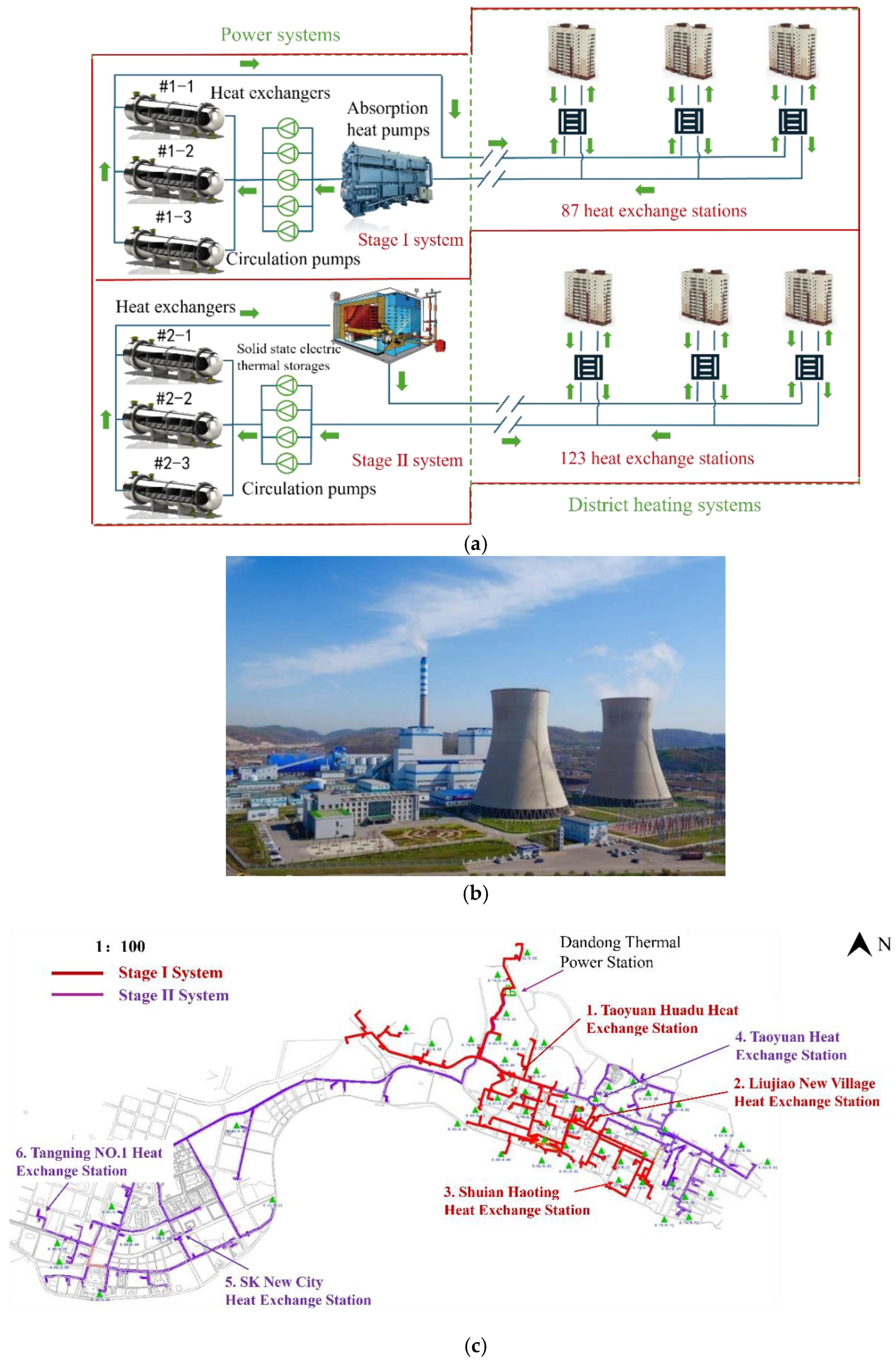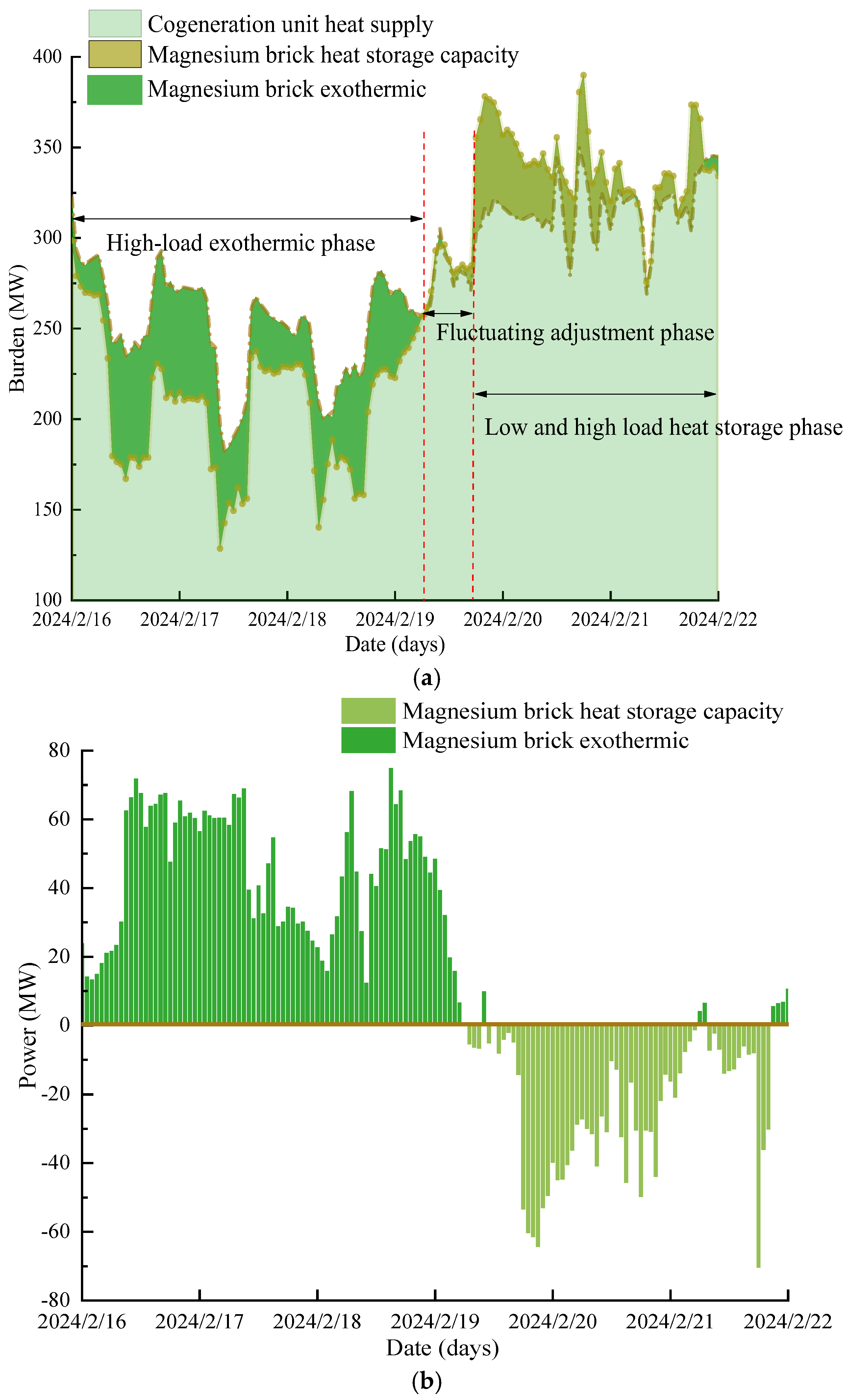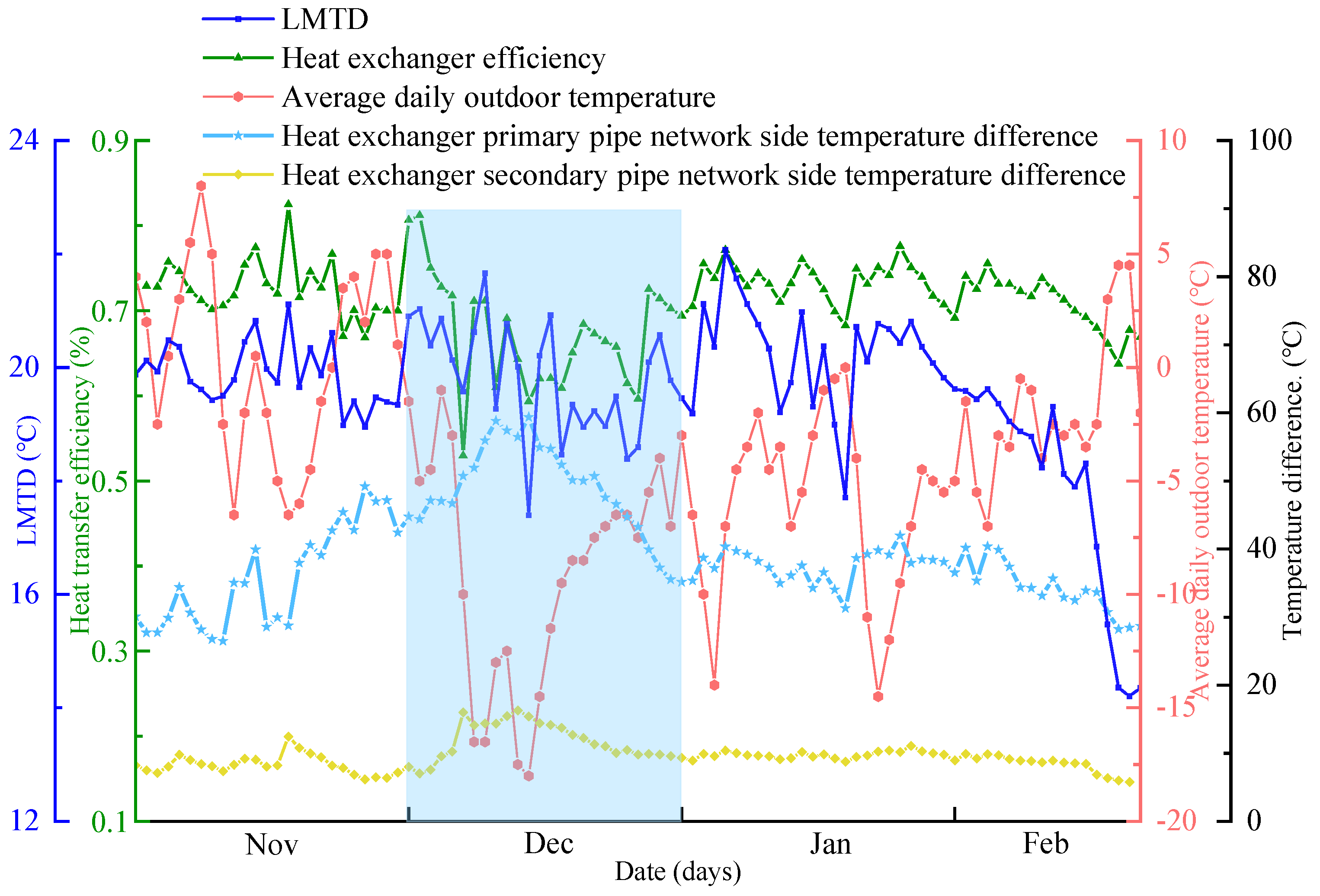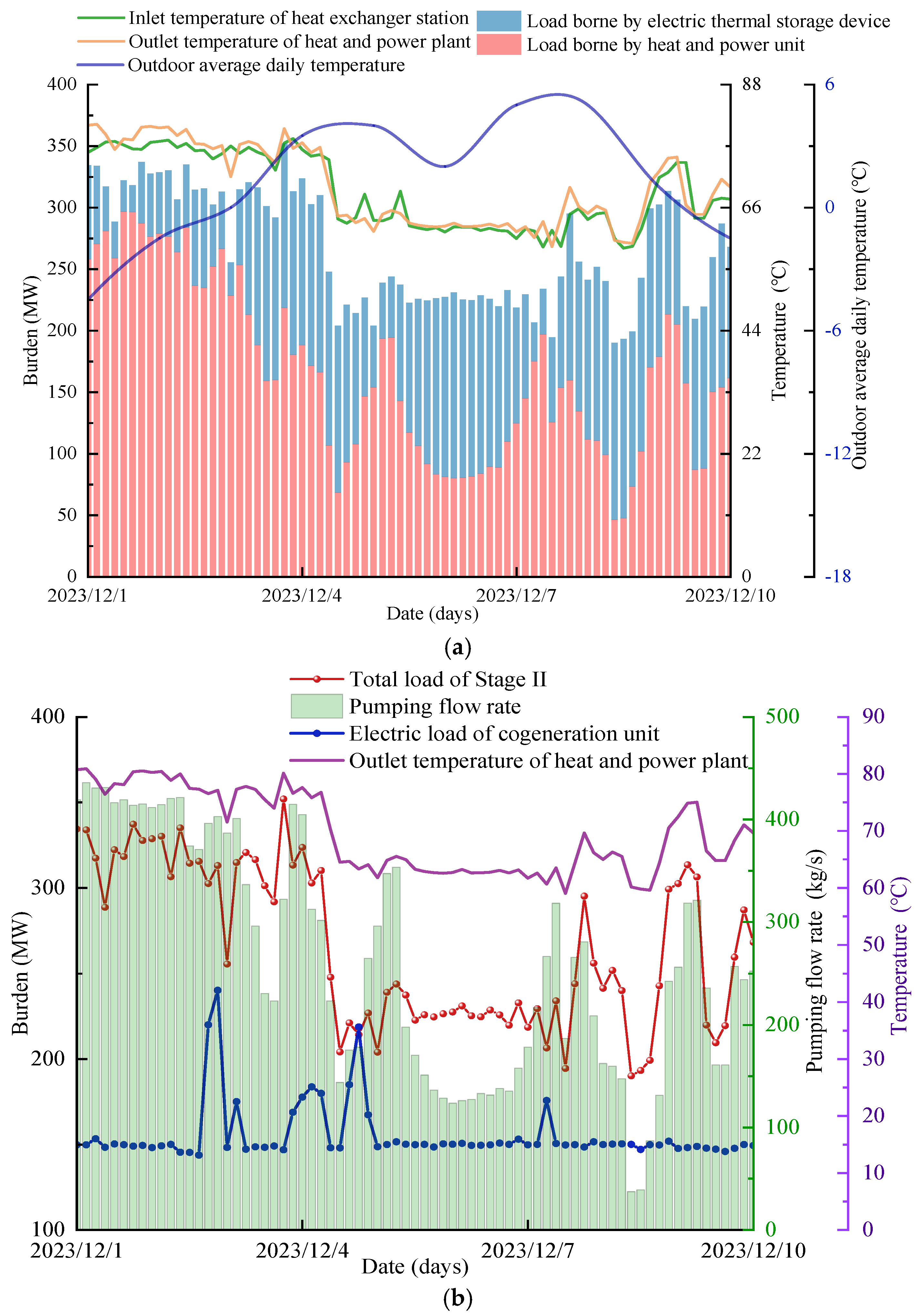Coordinated Scheduling and Operational Characterization of Electricity and District Heating Systems: A Case Study
Abstract
:1. Introduction
2. Method
2.1. System Overview
2.1.1. History of Thermal Power Plant Renovation
2.1.2. Current Operation of the Thermal Power Plant Heating System
2.2. Environmental Benefit Assessment Method for AHPs
2.3. Heat Exchanger Efficiency Calculation Method in Heat Exchanger Stations
3. Results and Discussion
3.1. AHP Waste Heat Recovery System
3.1.1. Analysis of Actual AHP Operation
3.1.2. Analysis of the Environmental Benefits of AHPs
3.2. Application of Solid-State Electric Thermal Storage in Deep Peaking
3.3. Analysis of District Heating Systems
3.3.1. Heat Exchanger Efficiency in Heat Exchanger Stations
3.3.2. Temperature Decrease in the Primary Heating System Network
3.4. Overall Operational Analysis of Electricity and District Heating
3.4.1. Analysis of Overall System Operations for Stage I
3.4.2. Analysis of Overall System Operations for Stage II
4. Conclusions
- (1)
- AHPs and solid-state electric thermal storage technologies effectively enhanced the thermal balance and load regulation capabilities of the system. The waste heat recovery system was used to recover approximately 7.3 × 107 GJ of waste heat in one heating season, which can reduce 3.04 × 108 kg of water consumption and 0.78 × 108 kg of CO2 emissions. Solid-state electrical thermal storage can be divided into three phases: high-load heat release, fluctuation adjustment, and low-load heat storage. The implementation of effective heat storage and release strategies ensures reliable heating performance during load fluctuations.
- (2)
- In the combined heating system of AHPs and network heat exchangers, the thermal load output of the absorption heat pump remained stable, with the thermal power units continuing to serve as the core equipment for system peak load regulation. In the combined system of district heating network heat exchangers and electric thermal storage devices, the presence of electric thermal storage assists in smoothing out thermal load fluctuations. In addition, the electrical load exhibited minimal variation, maintaining a level of approximately 150 MW. Notably, significant fluctuations in the electrical load occur because of emergency grid dispatches and other external factors.
- (3)
- In district heating systems, particularly during long-distance pipeline transportation, significant thermal losses were observed. The temperature decrease in the water medium in the primary network is directly proportional to the pipeline distance. When the distance from the power plant outlet to the heat exchange station was 1175 and 14,665 m, the temperature decreased by 0.66 and 3.48 °C, respectively. The temperature decrease per unit pipe length was influenced by multiple factors, including the temperature gradient, reduced heat transfer to the surrounding soil, and operational parameters.
- (4)
- The ambient temperature significantly affected the LMTD and efficiency of heat exchangers in heat transfer stations, demonstrating a positive correlation between the two. When the outdoor temperature reached the annual minimum of −18 °C, the temperature difference between the supply and return of both the primary and secondary heating networks peaked, the efficiency of the heat exchanger decreased to 60%, and the LMTD decreased to 17.5 °C. Therefore, focusing on optimizing heat transfer stations and implementing energy-saving measures to ensure system efficiency is crucial for practical operations.
Author Contributions
Funding
Data Availability Statement
Conflicts of Interest
Nomenclature
| Additional heating area, m2 | |
| Specific heat capacity of circulating cooling water, J/(kg·°C) | |
| CO2 emissions, kg | |
| CO2 emission factor | |
| Latent heat of circulating water, kJ/kg | |
| Circulating cooling water flow, kg/s | |
| Circulating water dissipation, kg | |
| Coal consumption, kg | |
| Waste heat recovery, MW | |
| Heating capacity of the original heating system, MW | |
| Total system heat supply after modification, MW | |
| Waste heat recovery per unit heating capacity, MW/MW | |
| Primary network side flow rate, m3/h | |
| Secondary network side flow rate, m3/h | |
| Circulating cooling water inlet temperature, °C | |
| Circulating cooling water outlet temperature, °C | |
| Primary pipe network side inlet water temperature, °C | |
| Primary pipe network side outlet water temperature, °C | |
| Secondary pipe network side inlet water temperature, °C | |
| Secondary pipe network side outlet water temperature, °C | |
| Percentage increase in heat supply | |
| Thermal indicators for heating area, W/m2 | |
| Calorific value of standard coal, kJ/kg | |
| Heat exchanger efficiency | |
| Conversion efficiency | |
| Logarithmic mean temperature difference, °C |
References
- Brown, M.A.; Herrera, V.S. Combined heat and power as a platform for clean energy systems. Appl. Energy 2021, 304, 117686. [Google Scholar] [CrossRef]
- Zhang, H.; Li, Z.; Zhao, H. Thermodynamic performance analysis of a novel electricity-heating cogeneration system (EHCS) based on absorption heat pump applied in the coal-fired power plant. Energy Convers. Manag. 2015, 105, 1125–1137. [Google Scholar] [CrossRef]
- Li, P.; Wang, H.; Lv, Q.; Li, W. Combined Heat and Power Dispatch Considering Heat Storage of Both Buildings and Pipelines in District Heating System for Wind Power Integration. Energies 2017, 10, 893. [Google Scholar] [CrossRef]
- Li, X.; Li, W.; Zhang, R.; Jiang, T.; Chen, H.; Li, G. Collaborative scheduling and flexibility assessment of integrated electricity and district heating systems utilizing thermal inertia of district heating network and aggregated buildings. Appl. Energy 2020, 258, 114021. [Google Scholar] [CrossRef]
- Su, W.; Han, Y.; Liu, Z.; Jin, X.; Liu, Z.; Yang, D.; Zhang, X. Absorption heat pumps for low-grade heat utilization: A comprehensive review on working pairs, classification, system advances and applications. Energy Convers. Manag. 2024, 315, 118760. [Google Scholar] [CrossRef]
- Xu, Z.; Wang, R. Absorption heat pump for waste heat reuse: Current states and future development. Front. Energy 2017, 11, 414–436. [Google Scholar] [CrossRef]
- Xu, Z.; Mao, H.; Liu, D.; Wang, R. Waste heat recovery of power plant with large scale serial absorption heat pumps. Energy 2018, 165, 1097–1105. [Google Scholar] [CrossRef]
- Parham, K.; Khamooshi, M.; Tematio, D.B.K.; Yari, M.; Atikol, U. Absorption heat transformers—A comprehensive review. Renew. Sustain. Energy Rev. 2014, 34, 430–452. [Google Scholar] [CrossRef]
- Zhao, Z.; Zhang, X.; Ma, X. Thermodynamic performance of a double-effect absorption heat-transformer using TFE/E181 as the working fluid. Appl. Energy 2005, 82, 107–116. [Google Scholar] [CrossRef]
- Su, W.; Han, Y.; Jin, X.; Liu, Z.; Zhang, X. Energy, economic, and environmental evaluation of a GAX-based cross-type absorption-resorption heat pump. Energy Convers. Manag. 2024, 300, 117952. [Google Scholar] [CrossRef]
- Jia, T.; Dou, P.; Chen, E.; Dai, Y. Feasibility and performance analysis of a hybrid GAX-based absorption-compression heat pump system for space heating in extremely cold climate conditions. Energy 2022, 242, 122936. [Google Scholar] [CrossRef]
- Jia, T.; Chu, P.; Dou, P.; Dai, Y. Working domains of a novel solar-assisted GAX-based two-stage absorption-resorption heat pump with multiple internal heat recovery for space heating. Energy Convers. Manag. 2020, 220, 113060. [Google Scholar] [CrossRef]
- Bourouisa, M.; Coronas, A.; Romero, R.J.; Siqueiros, J. Purification of seawater using absorption heat transformers with water-(LiBr+LiI+LiNO3+LiCl) and low temperature heat sources. Desalination 2004, 166, 209–214. [Google Scholar] [CrossRef]
- Wu, W.; Zhang, X.; Li, X.; Shi, W.; Wang, B. Comparisons of different working pairs and cycles on the performance of absorption heat pump for heating and domestic hot water in cold regions. Appl. Therm. Eng. 2012, 48, 349–358. [Google Scholar] [CrossRef]
- Li, X.; Wu, W.; Zhang, X.; Shi, W.; Wang, B. Energy saving potential of low temperature hot water system based on air source absorption heat pump. Appl. Therm. Eng. 2012, 48, 317–324. [Google Scholar] [CrossRef]
- Sun, F.; Fu, L.; Sun, J.; Zhang, S. A new waste heat district heating system with combined heat and power (CHP) based on ejector heat exchangers and absorption heat pumps. Energy 2014, 69, 516–524. [Google Scholar] [CrossRef]
- Chen, Y.; Xu, J.; Zhao, D.; Wang, J.; Lund, P.D. Exergo-economic assessment and sensitivity analysis of a solar-driven combined cooling, heating and power system with organic Rankine cycle and absorption heat pump. Energy 2021, 230, 120717. [Google Scholar] [CrossRef]
- Rana, M.; Uddin, M.; Sarkar, R.; Meraj, S.T.; Shafiullah, G.; Muyeen, S.; Islam, A.; Jamal, T. Applications of energy storage systems in power grids with and without renewable energy integration—A comprehensive review. J. Energy Storage 2023, 68, 107811. [Google Scholar] [CrossRef]
- Ji, H.; Wang, H.; Yang, J.; Feng, J.; Yang, Y.; Okoye, M.O. Optimal schedule of solid electric thermal storage considering consumer behavior characteristics in combined electricity and heat networks. Energy 2021, 234, 121237. [Google Scholar] [CrossRef]
- Cisek, P.; Taler, D. Numerical analysis and performance assessment of the Thermal Energy Storage unit aimed to be utilized in Smart Electric Thermal Storage (SETS). Energy 2019, 173, 755–771. [Google Scholar] [CrossRef]
- Ma, Y.; Wang, S.; Yang, H.; Zhang, D.; Shen, Y. Two-stage optimization model for day-ahead scheduling of electricity- heat microgrids with solid electric thermal storage considering heat flexibility. J. Energy Storage 2024, 95. [Google Scholar] [CrossRef]
- Guruprasad, A.; Yaxue, L.; Guiyin, F. An overview of thermal energy storage systems. Energy 2018, 144, 341–378. [Google Scholar]
- Dai, Y.; Chen, L.; Min, Y.; Mancarella, P.; Chen, Q.; Hao, J.; Hu, K.; Xu, F. Integrated Dispatch Model for Combined Heat and Power Plant with Phase-Change Thermal Energy Storage Considering Heat Transfer Process. IEEE Trans. Sustain. Energy 2018, 9, 1234–1243. [Google Scholar] [CrossRef]
- Meng, F.; Lu, Z.; Li, X.; Han, W.; Peng, J.; Liu, X.; Niu, Z. Demand-side energy management reimagined: A comprehensive literature analysis leveraging large language models. Energy 2024, 291, 130303. [Google Scholar] [CrossRef]
- Behrangrad, M. A review of demand side management business models in the electricity market. Renew. Sustain. Energy Rev. 2015, 47, 270–283. [Google Scholar] [CrossRef]
- Saffari, M.; de Gracia, A.; Fernández, C.; Belusko, M.; Boer, D.; Cabeza, L.F. Optimized demand side management (DSM) of peak electricity demand by coupling low temperature thermal energy storage (TES) and solar PV. Appl. Energy 2018, 211, 604–616. [Google Scholar] [CrossRef]
- Yifan, Z.; Wei, H.; Le, Z.; Yong, M.; Lei, C.; Zongxiang, L.; Ling, D. Power and energy flexibility of district heating system and its application in wide-area power and heat dispatch. Energy 2020, 190, 116426. [Google Scholar] [CrossRef]
- Zhang, M.; Wu, Q.; Wen, J.; Lin, Z.; Fang, F.; Chen, Q. Optimal operation of integrated electricity and heat system: A review of modeling and solution methods. Renew. Sustain. Energy Rev. 2021, 135, 110098. [Google Scholar] [CrossRef]
- Konstantinaviciute, I.; Bobinaite, V. Comparative analysis of carbon dioxide emission factors for energy industries in European Union countries. Renew. Sustain. Energy Rev. 2015, 51, 603–612. [Google Scholar] [CrossRef]








| Region | ID | Heat Exchange Station | Connected Area (m2) | Primary Pipeline Length (m) |
|---|---|---|---|---|
| Stage I | 1 | Taoyuan Huadu | 83,086.39 | 2275 |
| 2 | Liujiao New Village | 38,350.86 | 5448 | |
| 3 | Shuian Haoting | 44,246.14 | 7899 | |
| Stage II | 4 | Taoyuan | 162,380.51 | 4389 |
| 5 | SK New City | 107,406.17 | 11,236 | |
| 6 | Tangning No. 1 | 176,043.01 | 14,665 |
Disclaimer/Publisher’s Note: The statements, opinions and data contained in all publications are solely those of the individual author(s) and contributor(s) and not of MDPI and/or the editor(s). MDPI and/or the editor(s) disclaim responsibility for any injury to people or property resulting from any ideas, methods, instructions or products referred to in the content. |
© 2025 by the authors. Licensee MDPI, Basel, Switzerland. This article is an open access article distributed under the terms and conditions of the Creative Commons Attribution (CC BY) license (https://creativecommons.org/licenses/by/4.0/).
Share and Cite
Yu, P.; Li, D.; Cui, D.; Xu, J.; Li, C.; Cao, H. Coordinated Scheduling and Operational Characterization of Electricity and District Heating Systems: A Case Study. Energies 2025, 18, 2211. https://doi.org/10.3390/en18092211
Yu P, Li D, Cui D, Xu J, Li C, Cao H. Coordinated Scheduling and Operational Characterization of Electricity and District Heating Systems: A Case Study. Energies. 2025; 18(9):2211. https://doi.org/10.3390/en18092211
Chicago/Turabian StyleYu, Peng, Dianyang Li, Dai Cui, Jing Xu, Chengcheng Li, and Huiqing Cao. 2025. "Coordinated Scheduling and Operational Characterization of Electricity and District Heating Systems: A Case Study" Energies 18, no. 9: 2211. https://doi.org/10.3390/en18092211
APA StyleYu, P., Li, D., Cui, D., Xu, J., Li, C., & Cao, H. (2025). Coordinated Scheduling and Operational Characterization of Electricity and District Heating Systems: A Case Study. Energies, 18(9), 2211. https://doi.org/10.3390/en18092211





